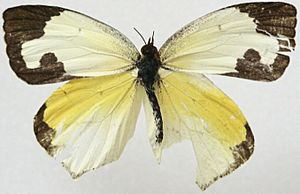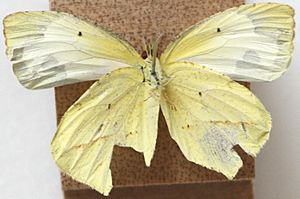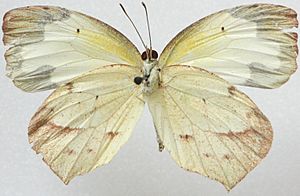Mexican yellow facts for kids
The Mexican yellow, sometimes called the wolf-face sulphur, is a beautiful butterfly found in North and South America. It belongs to the Pieridae family, which includes many yellow and white butterflies. You'll mostly find it in Mexico, but sometimes it flies into the central and southwestern United States, and very rarely even reaches Canada.
Quick facts for kids Mexican yellow |
|
|---|---|
 |
|
| Male | |
 |
|
| Female | |
| Scientific classification | |
| Synonyms | |
|
Contents
Discover the Mexican Yellow Butterfly
What Does the Mexican Yellow Look Like?
The top side of this butterfly's wings is a pale yellow color. The front wings have a black border near the edge. This border creates a cool "dog" or "wolf-face" shape! The back wings have a smaller black border.
Male Mexican yellows have a bright yellow patch on the front edge of their back wings. The underside of the wings is pale yellow during summer. In winter, they can be pale yellow with reddish marks, or even completely reddish-pink. The back wings are quite pointy. These butterflies have a wingspan of about 1¼ to 2¼ inches (32–57 mm).
How to Tell Similar Butterflies Apart
There are other butterflies that look a bit like the Mexican yellow. These include Boisduval's yellow (Eurema boisduvaliana) and the Salome yellow (Eurema salome).
Boisduval's yellow is smaller and a brighter yellow. The male's "dog face" pattern is not as strong. The female has less black on her upper wings. Also, its back wings are not as pointy.
The Salome yellow is also a brighter yellow. It has less black on the top of its wings. On the underside of its back wing, you might see a round reddish spot near the back edge.
Where the Mexican Yellow Lives
Habitat and Environment
The Mexican yellow butterfly lives in many different open areas. You can find it in places like the edges of woodlands, open forests, and desert grasslands.
When and Where They Fly
You can spot this butterfly almost all year in Arizona and Texas. In New Mexico, they fly from April to November. Sometimes, in late summer, they fly northward, even reaching Canada on rare occasions.
Mexican Yellow Life Cycle
Reproduction and Development
Male Mexican yellow butterflies spend all day flying around, looking for females. The young larva (caterpillar) is green. It has a creamy or yellow stripe down its back and another yellow stripe along its side. The Mexican yellow butterfly usually has 3 to 4 groups of broods each year.
What Do Mexican Yellow Caterpillars Eat?
The caterpillars of the Mexican yellow butterfly eat leaves from certain plants. These plants are called "host plants." Here are some of their favorites:
- New Mexican locust, Robinia neomexicana
- Fern acacia, Acacia angustissima
- Prairie acacia, Acacia angustissima var. hirta
- Cassia species
- Diphysa robinoides
See also
 In Spanish: Amarilla mexicana para niños
In Spanish: Amarilla mexicana para niños



